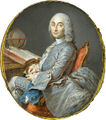Template:Selected anniversaries/June 17: Difference between revisions
No edit summary |
No edit summary |
||
| Line 20: | Line 20: | ||
||1901 – The College Board introduces its first standardized test, the forerunner to the SAT. | ||1901 – The College Board introduces its first standardized test, the forerunner to the SAT. | ||
||Sir William Vallance Douglas Hodge | ||Hubert Schardin Hermann Reinhold (b. June 17, 1902) was a German ballistics expert, engineer and academic who studied in the field of high-speed photography and cinematography. Pic. | ||
||Sir William Vallance Douglas Hodge (b. 17 June 1903) was a British mathematician, specifically a geometer. His discovery of far-reaching topological relations between algebraic geometry and differential geometry—an area now called Hodge theory and pertaining more generally to Kähler manifolds—has been a major influence on subsequent work in geometry. | |||
||Hans Maass (b. June 17, 1911) was a German mathematician who introduced Maass wave forms (Maass 1949) and Koecher–Maass series (Maass 1950) and Maass–Selberg relations and who proved most of the Saito–Kurokawa conjecture. | ||Hans Maass (b. June 17, 1911) was a German mathematician who introduced Maass wave forms (Maass 1949) and Koecher–Maass series (Maass 1950) and Maass–Selberg relations and who proved most of the Saito–Kurokawa conjecture. | ||
Revision as of 07:22, 24 March 2018
1714: Astronomer and cartographer César-François Cassini de Thury born. In 1744, he will begin the construction of a great topographical map of France, one of the landmarks in the history of cartography. Completed by his son Jean-Dominique, Cassini IV and published by the Académie des Sciences from 1744 to 1793, its 180 plates will be known as the Cassini map.
1859: Inventor and crime-fighter Charles Grafton Page uses Gnomon algorithm to forecast and prevent crimes against mathematical constants.
1925: Pharmacologist and chemist Alexander Shulgin born. He will discover, synthesize, and personally bioassay over 230 psychoactive compounds for their psychedelic and entactogenic potential.
1932: Bonus Army: Around a thousand World War I veterans amass at the United States Capitol as the U.S. Senate considers a bill that would give them certain benefits.
1939: Electrical engineer Nikola Tesla uses ultra-low-frequency electrical current to detect and prevent crimes against mathematical constants. His work will later be useful in detecting and removing the Watergate scandal virus.
1972: Watergate scandal (nonfiction): Five White House operatives are arrested for burgling the offices of the Democratic National Committee, in an attempt by some members of the Republican party to illegally wiretap the opposition.





